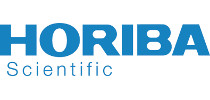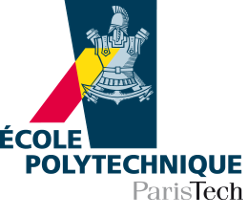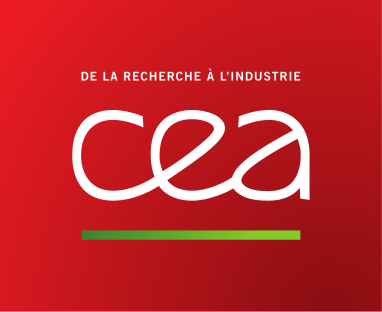Poster Prize Recipients in LEES 2014
Almost 60 posters were presented in the LEES 2014 meeting. The members of the Program Committee and the International Advisory Committee were consulted to select 4 posters which were given a 500 € prize each. The recipients (in alphabetical order) were:
- Siham Benhabib (University of Paris 7)
- Veronica Goian (Czech Academy of Sciences)
- Alexander McLeod (USCD)
- Michael Tran (Université de Génève)
Siham Benhabib
|
Siham Benhabib -- Université Paris 7 Collapse of the Pseudogap in Cuprate superconductors at a Lifshitz Transition (Expand...)
S. Benhabib, A. Sacuto, M. Civelli, I. Paul, M. Cazayous, Y. Gallais, M.-A. Méasson, R. D. Zhong, J. Schneeloch, G. D. Gu, D. Colson and A.Forget
In the under-doped side of the hole doped cuprate phase diagram, the loss of well defined low energy excitations described as the pseudogap develops above the critical temperature $T_c$ [1]. The relation between pseudo- and superconducting gaps has been a controversial issue whose understanding may provide long-sought insights into the mechanism of high temperature superconductivity [2]. Although intensely studied in the underdoped regime, relatively less is known about the pseudogap on the over-doped side, where it weakens and eventually disappears at a critical doping $p_c$ [3]. Here, we handle a carful finely tuned Electronic Raman study of Bi$_{2}$Sr$_{2}$CaCu$_{2}$O$_{8+\delta}$ in a large range of doping from under doped to heavy over doped, (the doping was controlled by oxygen insertion). We succeed by combining experiment and theoretical calculations to determine the critical doping $p_c$ , which correspond to the pseudogap closing at $p_c =0.22$ and we reveal that it coincides with a Lifshitz transition where the underlying hole-like active Fermi surface becomes electron-like at a van Hove singularity [4]. Interestingly, the superconducting critical temperature $T_c$ is unaffected by this transition. Comparing our results with existing photoemission and tunnelling data, we demonstrate that the microscopic origins of the pseudogap and the superconductivity are different on the over-doped side. Only the former is tied to the change in the Fermi surface topology, a feature universal across several hole doped cuprates [4]. (2) M. Norman, D. Pines and C. Kallin The pseudogap: friend or foe of high Tc? Adv. Phys. 54, 712 (2005). (1) T. Timusk and B. Statt, The pseudogap in high-temperature superconductors: an experimental survey. Rep. Prog. Phys. 62 122(1999). (2) M. Norman, D. Pines and C. Kallin The pseudogap: friend or foe of high Tc? , Adv. Phys. 54, 712 (2005). (3) J. Tallon, and J. Loram, The doping dependence of T$^*$, what is the real high-Tc phase diagram? Physica C 349 , 53 (2001). (4) S. Benhabib, A. Sacuto, M.Civelli, I. Paul et al. Submitted , see arxiv april 1rst 2014. |
|

|
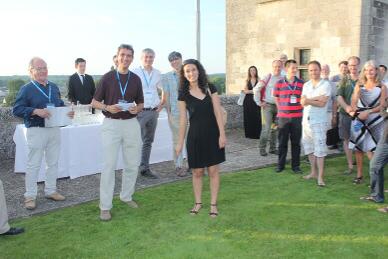
|
| (S. Benhabib - High res. ∼8 MB image) | (S. Benhabib - High res. ∼8 MB image) |
Veronica Goian
|
Veronica Goian -- Czech Academy of Sciences Strain engineering of EuO thin films (Expand...)
V. Goian, R. Held, A. Melville, S. Kamba, E. Bousquet, D. G. Schlom
Several years ago, it was demonstrated that biaxial strain can induce the ferroelectric and ferromagnetic state in epitaxial thin films of EuTiO$_3$, a material that is paraelectric and antiferromagnetic in the bulk \cite{lee}. We found that 1\% tensile strain in EuTiO$_3$/DyScO$_3$ induces ferroelectricity at 250 K and ferromagnetism at 4.2 K \cite{lee}. Here, we will focus on the study of EuO thin films, in which first principles calculations \cite{bousquet} predicted the emergence of a multiferroic state under expitaxial strains larger than +4\%. Note that bulk EuO is paraelectric at all temperatures and becomes ferromagnetic below 69 K. Strained EuO films with ferroelectric and ferromagnetic orders should exhibit a strong magnetoelectric coupling, much stronger than in most multiferroics with antiferromagnetic and ferroelectric orders \cite{erenstein}. Direct low-frequency dielectric measurements are impossible due to a leakage current present in the strained thin films. Therefore we have used IR spectroscopy, which is not influenced by electrical leakage. The predicted ferroelectric phase transition should be proper and displacive, therefore a strong soft mode anomaly should be observed at T$_C$. We have investigated using IR spectroscopy EuO thin films grown by molecular beam epitaxy on three different substrates leading to three different strain states. We also measured several (EuO)$_n$(BaO)$_m $ superlattices deposited on YAlO$_3$ and Si substrates. The films deposited on yttrium-stabilized ZrO$_2$ (YSZ) are virtually lattice-matched whereas the films deposited on LuAlO$_3$ and YAlO$_3$ are biaxially strained in an anisotropic way with in-plane tensile strains up to +1.5\% and +2.2\%, respectively. The EuO cubic crystal has only one IR active phonon with frequency lying as function of the sample quality between 180 and 200 cm$^{-1}$ \cite{gunthenrodt,axe}. Stronger phonon shifts were observed in the EuO/YAlO$_3$. In this case, phonon frequency shifts down to 149 cm$^{-1}$ (300 K), with a further softening to 144 cm$^{-1}$ on cooling to 10 K while in EuO/YSZ and EuO/LuAlO$_3$ a small influence of the strain on the optical phonon was observed. The strain influence on the soft mode is smaller than predicted in Ref. \cite{bousquet} which leads to the conclusion that the strain required to induce the ferroelectric phase induction may also be higher than the previously predicted 4\%. With increasing strain and film thickness, relaxation of the strain in the films, e.g. by formation of edge dislocations, becomes more pronounced. In case of EuO, ultrathin ($\ll 5$ nm) films are required to achieve homogeneous strains higher than 4\%. Phonons from such thin films give a very weak signal in IR spectra. For this reason we have decided to study EuO/BaO superlattices, where the BaO interlayers help to keep the strain. Higher tensile strain values of almost +5.6\% for the EuO layers were obtained in a (EuO)$_2$(BaO)$_6$ superlattice (28 stacks) deposited on silicon. In this case, the EuO layers had total thickness of 15 nm, and the BaO layers had total thickness of 46 nm and were compressively strained by -1.6\% In case of this sample, we were able to see two stiffened BaO phonons near 177 (300 K) and 164 cm$^{-1}$ (10 K) while the EuO phonon softened from 97 cm$^{-1}$ (300 K) down to 89 cm$^{-1}$ (10 K). We observed a strong influence of strain on the phonon modes in EuO and (EuO)$_n$(BaO)$_m$ superlattices. However, higher strains than 5.6\% seem to be necessary for the induction of ferroelectricity in EuO thin films and superlattices. New first-principles calculations that are able to better describe the experimental situation suggest that strain values above 6\% may indeed be sufficient to induce ferroelectricity in (EuO)$_n$(BaO)$_m$ superlattices. Deposition of new EuO/BaO superlattices with higher strain values is in progress. J.H. Lee et al. Nature, 466, 954 (2010); ibid 476, 114 (2011). E. Bousquet, N.A. Spaldin et al., Phys. Rev. Lett. 104, 037601 (2010). W. Eerenstein, N.D. Mathur, J. F. Scott, Nature, 442, 759. G. Gunthenrodt, Phys. Cond. Matter. 18, 37-78(1974). J.D. Axe, J. Phys. Chem. Solids, 30, 1403 (1969). |
|

|
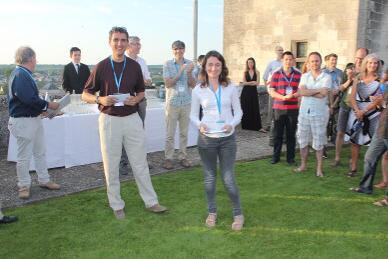
|
| (V. Goian - High res. ∼8 MB image) | (V. Goian - High res. ∼8 MB image) |
Alexander McLeod
|
Alexander McLeod -- UCSD Cryogenic Infrared Nano-Imaging of the Metal-Insulator Transition in the Canonical Mott Insulator V2O3 (Expand...)
A.S. McLeod, E. van Heumen, J.G. Ramirez, M. Goldflam, S. Wang, T. Saerbeck, I.K. Schuller, D.N. Basov
We report on temperature-dependent (20K-300K) near-field infrared imaging of the canonical Mott insulator V2O3 across its temperature-driven metal-insulator transition. This was accomplished using a home-built s-SNOM (scattering-type scanning near-field optical microscope) affording unprecedented spatial sensitivity (10 nm resolution) to surface optical properties with simultaneously acquired AFM topography at cryogenic temperatures. Our V2O3 thin film is found to exhibit extreme nano-scale electronic heterogeneity near the Mott transition (170K) from paramagnetic metal to antiferromagnetic insulator. Through a sequence of near-field infrared images acquired across the transition, we resolve dynamic spatial correlations and competition between electronic phases, offering a direct probe of the metal/insulator fill fraction in strong agreement with macroscopic transport and magnetic susceptibility. A statistical analysis of our near-field images in comparis on with X-ray diffraction imply decoupled electronic and structural transitions, enabling a nano-scale assessment of bandwidth and many-body effects within our film, while also resolving long-standing controversies surrounding the Mott physics of V2O3. |
|

|
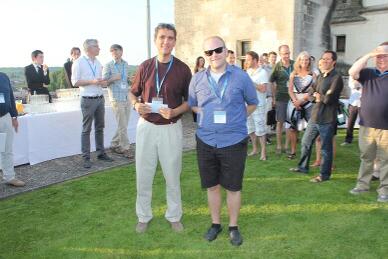
|
| (A. McLeod - High res. ∼8 MB image) | (A. McLeod - High res. ∼8 MB image) |
Michael Tran
|
Michael Tran -- Université de Génève Infrared- and Raman-Spectroscopy Measurements of a Transition in the Crystal Structure and a Closing of the Energy Gap of BiTeI under Pressure (Expand...)
M. K. Tran, J. Levallois, P. Lerch, J. Teyssier, A. B. Kuzmenko, G. Autès, O. V. Yazyev, A. Ubaldini, E. Giannini, D. van der Marel, A. Akrap
BiTeI is a giant Rashba spin splitting system, in which a noncentrosymmetric topological phase has recently been suggested to appear under high pressure. We investigated the optical properties of this compound, reflectivity and transmission, under pressures up to $15$~GPa. The gap feature in the optical conductivity vanishes above $p \sim 9$~GPa and does not reappear up to at least $15$~GPa. The plasma edge, associated with intrinsically doped charge carriers, is smeared out through a phase transition at $9$~GPa. Using high-pressure Raman spectroscopy, we follow the vibrational modes of BiTeI, providing additional clear evidence that the transition at 9 GPa involves a change of crystal structure. This change of crystal structure possibly inhibits the high-pressure topological phase from occurring. |
|

|
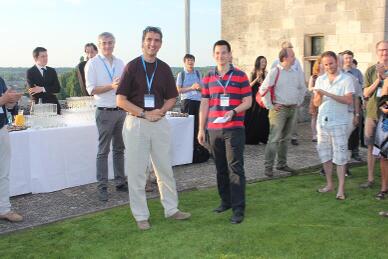
|
| (M. Tran - High res. ∼8 MB image) | (M. Tran - High res. ∼8 MB image) |



